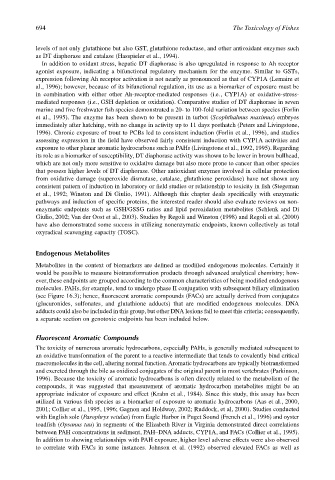Page 714 - The Toxicology of Fishes
P. 714
694 The Toxicology of Fishes
levels of not only glutathione but also GST, glutathione reductase, and other antioxidant enzymes such
as DT diaphorase and catalase (Hasspieler et al., 1994).
In addition to oxidant stress, hepatic DT diaphorase is also upregulated in response to Ah receptor
agonist exposure, indicating a bifunctional regulatory mechanism for the enzyme. Similar to GSTs,
expression following Ah receptor activation is not nearly as pronounced as that of CYP1A (Lemaire et
al., 1996); however, because of its bifunctional regulation, its use as a biomarker of exposure must be
in combination with either other Ah-receptor-mediated responses (i.e., CYP1A) or oxidative-stress-
mediated responses (i.e., GSH depletion or oxidation). Comparative studies of DT diaphorase in seven
marine and five freshwater fish species demonstrated a 20- to 100-fold variation between species (Forlin
et al., 1995). The enzyme has been shown to be present in turbot (Scophthalmus maximus) embryos
immediately after hatching, with no change in activity up to 11 days posthatch (Peters and Livingstone,
1996). Chronic exposure of trout to PCBs led to consistent induction (Forlin et al., 1996), and studies
assessing expression in the field have observed fairly consistent induction with CYP1A activities and
exposure to other planar aromatic hydrocarbons such as PAHs (Livingstone et al., 1992, 1995). Regarding
its role as a biomarker of susceptibility, DT diaphorase activity was shown to be lower in brown bullhead,
which are not only more sensitive to oxidative damage but also more prone to cancer than other species
that possess higher levels of DT diaphorase. Other antioxidant enzymes involved in cellular protection
from oxidative damage (superoxide dismutase, catalase, glutathione peroxidase) have not shown any
consistent pattern of induction in laboratory or field studies or relationship to toxicity in fish (Stegeman
et al., 1992; Winston and Di Giulio, 1991). Although this chapter deals specifically with enzymatic
pathways and induction of specific proteins, the interested reader should also evaluate reviews on non-
enzymatic endpoints such as GSH/GSSG ratios and lipid peroxidation metabolites (Schlenk and Di
Giulio, 2002; Van der Oost et al., 2003). Studies by Regoli and Winston (1998) and Regoli et al. (2000)
have also demonstrated some success in utilizing nonenzymatic endpoints, known collectively as total
oxyradical scavenging capacity (TOSC).
Endogenous Metabolites
Metabolites in the context of biomarkers are defined as modified endogenous molecules. Certainly it
would be possible to measure biotransformation products through advanced analytical chemistry; how-
ever, these endpoints are grouped according to the common characteristics of being modified endogenous
molecules. PAHs, for example, tend to undergo phase II conjugation with subsequent biliary elimination
(see Figure 16.3); hence, fluorescent aromatic compounds (FACs) are actually derived from conjugates
(glucuronides, sulfonates, and glutathione adducts) that are modified endogenous molecules. DNA
adducts could also be included in this group, but other DNA lesions fail to meet this criteria; consequently,
a separate section on genotoxic endpoints has been included below.
Fluorescent Aromatic Compounds
The toxicity of numerous aromatic hydrocarbons, especially PAHs, is generally mediated subsequent to
an oxidative transformation of the parent to a reactive intermediate that tends to covalently bind critical
macromolecules in the cell, altering normal function. Aromatic hydrocarbons are typically biotransformed
and excreted through the bile as oxidized conjugates of the original parent in most vertebrates (Parkinson,
1996). Because the toxicity of aromatic hydrocarbons is often directly related to the metabolism of the
compounds, it was suggested that measurement of aromatic hydrocarbon metabolites might be an
appropriate indicator of exposure and effect (Krahn et al., 1984). Since this study, this assay has been
utilized in various fish species as a biomarker of exposure to aromatic hydrocarbons (Aas et al., 2000,
2001; Collier et al., 1995, 1996; Gagnon and Holdway, 2002; Ruddock, et al, 2000). Studies conducted
with English sole (Parophrys vetulus) from Eagle Harbor in Puget Sound (French et al., 1996) and oyster
toadfish (Opsanus tau) in segments of the Elizabeth River in Virginia demonstrated direct correlations
between PAH concentrations in sediment, PAH–DNA adducts, CYP1A, and FACs (Collier et al., 1995).
In addition to showing relationships with PAH exposure, higher level adverse effects were also observed
to correlate with FACs in some instances. Johnson et al. (1992) observed elevated FACs as well as

